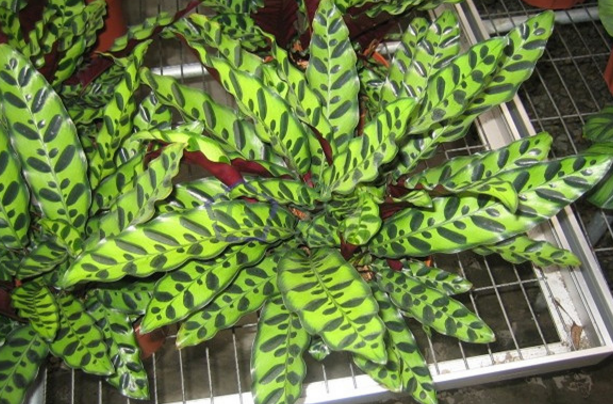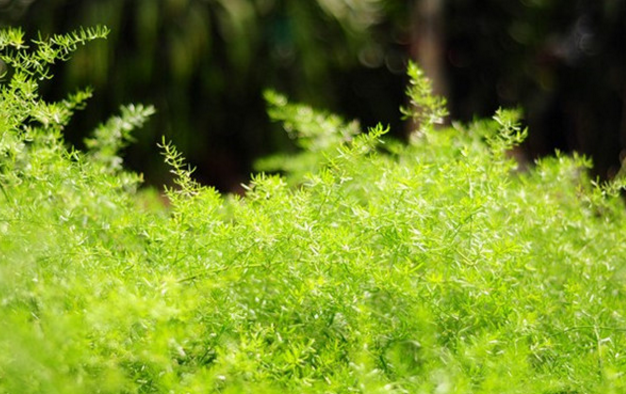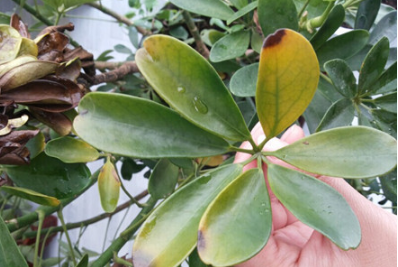Is the Cat's Eye Taro poisonous? breeding methods
Cat's eye taro leaves are broad, and the round black spots on the leaves are like the eyes of pandas, which are interesting and suitable for indoor decoration and beautification. But many people are worried about whether its color is toxic, so let's explore it together.
Is the cat's eye taro poisonous?
Flower friends in the breeding process are more concerned about the safety of the plant itself, long-term co-existence of a room will not endanger human health. So is the cat's eye taro poisonous?
Although the cat's eye taro looks colorful, it is actually a "safe" plant, so don't be fooled by its appearance. Cat's eye taro is not only non-toxic, but also absorbs formaldehyde, ammonia and other toxic gases, to achieve the effect of purifying the air, suitable for just decorated houses or bathrooms.

Can I put the cat's eye taro in the bedroom?
According to the above, cat's eye taro is not only non-toxic, but also a high-quality foliage plant that purifies the air and absorbs formaldehyde. It is evergreen all the year round and can be raised in the bedroom. It not only adds greenness to the bedroom, plays a role in beautification, but also purifies the living environment. But it is best not to put it at the head of the bed. Putting the plant at the head of the bed will reduce the oxygen content nearby, which is not conducive to the breathing of the human body in deep sleep. Because plants also have to breathe at night, they will "compete" for oxygen. However, the cat's eye taro plant type is not large, oxygen consumption is not much, do not worry too much, generally far away from the bedside.
Culture methods of Cat's Eye Taro:
1. Temperature
Cat's eye bamboo taro is native to tropical and subtropical regions and is resistant to high temperature. It is suitable to be in the growth environment of 20-30 ℃. The most suitable growth temperature in winter should be about 16-18 ℃.
2. Lighting
Shade-tolerant plants, sexual preference for semi-shade, should be placed in a bright indoor light. Avoid direct sunlight, exposure, etc., in order to avoid burning leaves. Shading and ventilation should be done well in summer.
3. Watering
In the growth period of cat's eye taro, it is necessary to fully water the soil and keep the soil moist. At the same time, we should also pay attention to avoid causing stagnant water in the soil, so as not to cause rotten roots and even cause plant death. As the leaves of the cat's eye taro are larger and the water evaporates quickly, it is necessary to maintain a high air humidity around it. The leaves can be sprayed frequently to keep the air around the leaves moist, which is beneficial to the growth and extension of the leaves. Once the leaves are found to curl and atrophy, it means that the plant is in a state of lack of water.
4. Fertilizer
Follow the principle of "giving frequently and sparingly". Stop fertilizing during the dormant period in winter and the high temperature in summer.
Matters needing attention in the culture of cat's eye taro:
1. Change the basin
Change the basin every other year, it is appropriate to choose fertile, loose, good air permeability and drainage, containing rich humus slightly acidic soil.
2. Pest control
The main common insect pests are shell insects, red spiders and so on. For scale insects, 40% omethoate 1000 times or 50% dichlorvos 1000 times and 2.5% deltamethrin 3000 times can be sprayed to control the disease. For red spiders, the control is usually carried out during the adult period after the eggs are hatched, which can be sprayed with 1000 times of dicofol EC or 1000 times of omethoate EC.
3. Disease control
The main common diseases are white silk disease, leaf spot and so on. For white silk disease, 0.2% of the soil weight can be added to 70% of the pentachloronitrobenzene to disinfect the soil, while the diseased plants and soil are removed, new soil is added, and ventilation is done. For leaf spot disease, the diseased leaves should be removed in time and base fertilizer should be applied to enhance disease resistance.
Is the Cat's Eye Amorphophallus poisonous? the breeding method of Cat's Eye Amorphophallus
Cat's eye taro is very popular, but many friends do not know, is cat's eye taro poisonous? What is the breeding method of cat's eye taro? I'm going to explain the answer to you today.
Is the cat's eye taro poisonous?
With regard to this problem, the editor can tell you for sure that cat's eye taro is not toxic. Cat's eye taro is not only non-toxic, but also can purify the air and absorb harmful gases such as formaldehyde and ammonia. The formaldehyde removal efficiency of cat's eye taro is half of that of hanging orchid, but it is much higher than that of ordinary plants, so it is better to put cat's eye taro in the newly decorated house.
Cat's eye bamboo taro is also a master at removing ammonia pollution from the air. Cat's eye bamboo taro can remove formaldehyde 0.86mg and ammonia 2.19mg within 10 square meters, so putting it in the bathroom is also a good choice. Cat's eye taro is a common indoor foliage plant, which is evergreen all the year round and has high ornamental value. Cat's eye taro is not poisonous, so you can breed it at ease.
Propagation method of Cat's Eye Taro
Amorphophallus maoyanensis is generally propagated by individual plants, which is more common than that in late spring and early summer when the temperature is about 20 ℃. When the temperature is too low, the ramet of cat's eye taro is easy to hurt the root, affect the survival or weaken the growth. When dividing the plant, the mother plant was deducted from the basin, the persistent soil was removed, and the dense plant was cut along the growth direction of the underground rhizome with a sharp knife, so that each clump had 3 sprouts and strong roots. Immediately after the cat's eye bamboo taro is cut, it is fully watered in the basin and placed in a cool place. It is better to gradually move to the light after a week. It is appropriate to control the moisture at the initial stage and fully water after the new root is sent.
Cat's-eye bamboo taro requires loose soil, rich in humus and good drainage. Pot cultivation of cat-eye bamboo taro should use loose, fertile, well-drained and humus-rich slightly acidic loam. Generally, it can be prepared with 3 portions of rotten leaf soil, 1 part of peat or sawdust and 1 part of sand, and a small amount of bean cake is added as base fertilizer. When the cat's eye taro is to be put on the basin, the bottom of the basin is padded with 3 cm thick coarse sand as a drainage layer to facilitate drainage. When changing pots, new culture soil should be added, and the residual roots and leaves of taro should be cut off and replanted to facilitate the growth of taro.
More information cat's eye taro poisonous cat's eye taro can be put in the indoor bedroom
Cat's eye taro is a kind of ornamental plant, which has a very rich and colorful leaf color, which is very suitable for ornamental and decoration. However, its leaves have round black spots, and many unfamiliar friends mistakenly think that cat's eye taro is a poisonous plant. In fact, these black spots are its unique scenery, as to whether it is poisonous or not, the editor will take you to reveal the secret.
Is the cat's eye taro poisonous?
Although the cat's eye taro looks colorful, it is actually a "safe" plant, so don't be fooled by its appearance. Cat's eye taro is not only non-toxic, but also absorbs formaldehyde, ammonia and other toxic gases, to achieve the effect of purifying the air, suitable for just decorated houses or bathrooms.
Can I put the cat's eye taro in the indoor bedroom?
According to the above, cat's eye taro is not only non-toxic, but also a high-quality foliage plant that purifies the air and absorbs formaldehyde. It is evergreen all the year round and can be raised in the bedroom. It not only adds greenness to the bedroom, plays a role in beautification, but also purifies the living environment.
But it is best not to put it at the head of the bed. Putting the plant at the head of the bed will reduce the oxygen content nearby, which is not conducive to the breathing of the human body in deep sleep. Because plants also have to breathe at night, they will "compete" for oxygen. However, the cat's eye taro plant type is not large, oxygen consumption is not much, do not worry too much, generally far away from the bedside.
Culture methods and matters needing attention of Cat's Eye Taro
I. Culture methods of Cat's Eye Taro
1. Temperature
Cat's eye bamboo taro is native to tropical and subtropical regions and is resistant to high temperature. It is suitable to be in the growth environment of 20-30 ℃. The most suitable growth temperature in winter should be about 16-18 ℃.
2. Lighting
Shade-tolerant plants, sexual preference for semi-shade, should be placed in a bright indoor light. Avoid direct sunlight, exposure, etc., in order to avoid burning leaves. Shading and ventilation should be done well in summer.
3. Watering
In the growth period of cat's eye taro, it is necessary to fully water the soil and keep the soil moist. At the same time, we should also pay attention to avoid causing stagnant water in the soil, so as not to cause rotten roots and even cause plant death. As the leaves of the cat's eye taro are larger and the water evaporates quickly, it is necessary to maintain a high air humidity around it. The leaves can be sprayed frequently to keep the air around the leaves moist, which is beneficial to the growth and extension of the leaves. Once the leaves are found to curl and atrophy, it means that the plant is in a state of lack of water.
4. Fertilizer
Follow the principle of "giving frequently and sparingly". Stop fertilizing during the dormant period in winter and the high temperature in summer.
2. matters needing attention in the culture of cat's-eye taro
1. Change the basin
Change the basin every other year, it is appropriate to choose fertile, loose, good air permeability and drainage, containing rich humus slightly acidic soil.
2. Pest control
The main common insect pests are shell insects, red spiders and so on. For scale insects, 40% omethoate 1000 times or 50% dichlorvos 1000 times and 2.5% deltamethrin 3000 times can be sprayed to control the disease.
3. Disease control
The main common diseases are white silk disease, leaf spot and so on. For white silk disease, 0.2% of the soil weight can be added to 70% of the pentachloronitrobenzene to disinfect the soil, while the diseased plants and soil are removed, new soil is added, and ventilation is done. For leaf spot disease, the diseased leaves should be removed in time and base fertilizer should be applied to enhance disease resistance.
What if the leaves of cat's eye bamboo taro are bent?
1. Reason: too little watering and insufficient humidity. Cat's-eye bamboo taro is native to tropical and subtropical regions and likes humid growing environment. In addition, its leaves are larger and water evaporates fast. if the surrounding air humidity is insufficient, the leaves will respond sensitively and become curved. Insufficient watering can easily cause the leaves of cat's eye taro to curl, wither and yellow, and some leaves die.
Treatment: increase watering, often spray to the leaves, keep the air around the leaves moist, pay attention to watering thoroughly, to prevent stagnant water in the basin, otherwise root rot will also lead to leaf bending and atrophy.
2. Reason: discomfort in temperature and humidity. Cat's eye bamboo taro likes high temperature, especially when the winter temperature is too low and the air is dry, the leaves are prone to bend and atrophy.
Treatment method: strengthen the water and fertilizer management and heat preservation of cat's eye taro. When the temperature is too low in winter, you can move the cat's eye taro to a warm place indoors, cover it with plastic bags, and poke some small holes in it for ventilation.
3. Reason: improper fertilization. Excessive concentration of fertilizer, or the application of large fertilizer, raw fertilizer, resulting in cat's-eye taro nutrient fibrous root rot, leaf curl.
Treatment method: immediately stop fertilization, in serious cases, need to change the basin soil, wash the residual fertilizer on the cat's eye taro plant.
Cat's-eye taro is native to the tropics, so it is not difficult to raise it. Can breed a pot to put in the indoor bright light place, and can be used as an ornament, but also can achieve the effect of purifying the air, you can have both fish and bear paws.
- Prev

Where can the breeding methods and matters needing attention of Tianmen winter be put?
Asparagus, also known as asparagus, is a perennial semi-vine green herb of Liliaceae. With fusiform roots, leaflike branches linear, clustered, flowers white or reddish, berries bright red. It is a kind of perennial herb, which is widely distributed in our country. Radix asparagus has a certain medicinal value.
- Next

What about the yellowing of the leaves of the cash cow? diseases and insect pests and their control
Money tree is a perennial evergreen herb, which is a kind of ornamental foliage plant. Let's go and learn more about the cash cow. What if the leaves of the money tree turn yellow? the money tree belongs to the perennial evergreen herbaceous plant. It is a very ornamental foliage plant. What if the leaves of the money tree turn yellow?
Related
- Fuxing push coffee new agricultural production and marketing class: lack of small-scale processing plants
- Jujube rice field leisure farm deep ploughing Yilan for five years to create a space for organic food and play
- Nongyu Farm-A trial of organic papaya for brave women with advanced technology
- Four points for attention in the prevention and control of diseases and insect pests of edible fungi
- How to add nutrient solution to Edible Fungi
- Is there any good way to control edible fungus mites?
- Open Inoculation Technology of Edible Fungi
- Is there any clever way to use fertilizer for edible fungus in winter?
- What agents are used to kill the pathogens of edible fungi in the mushroom shed?
- Rapid drying of Edible Fungi

